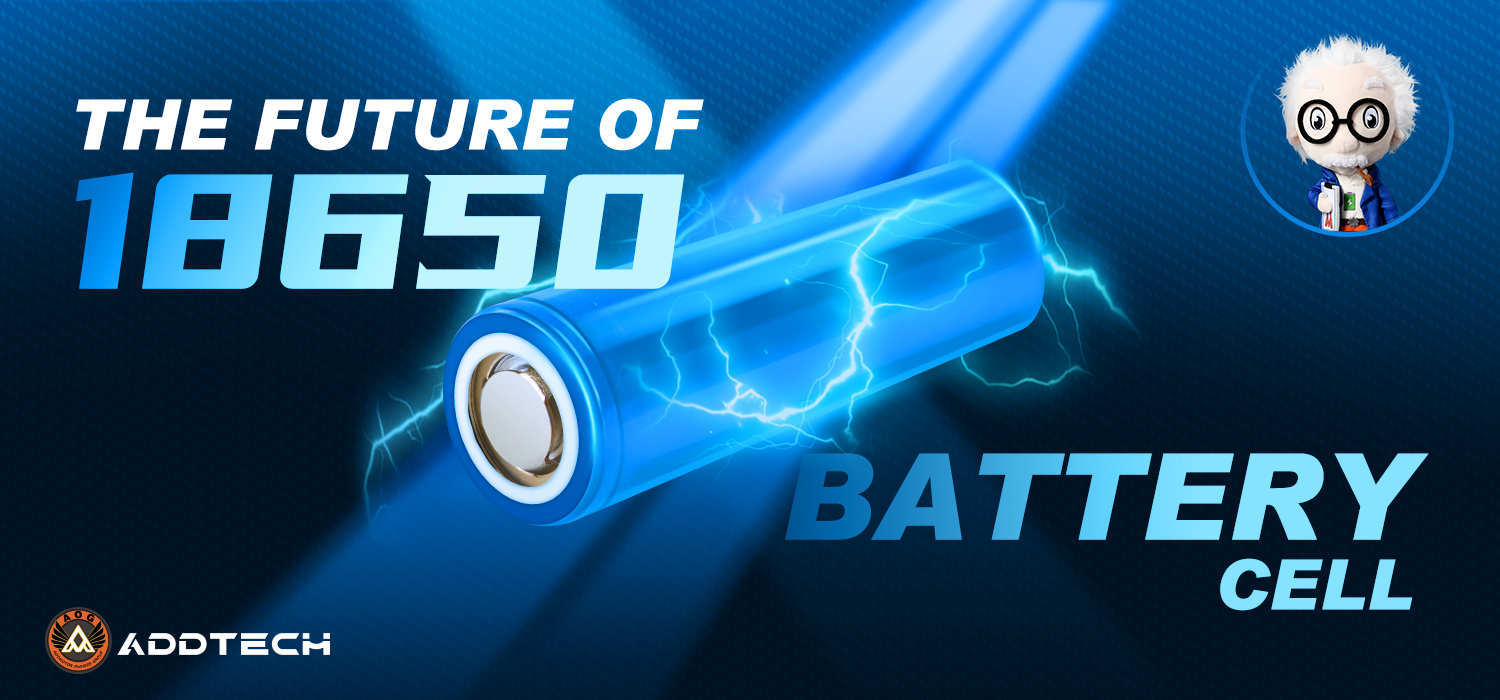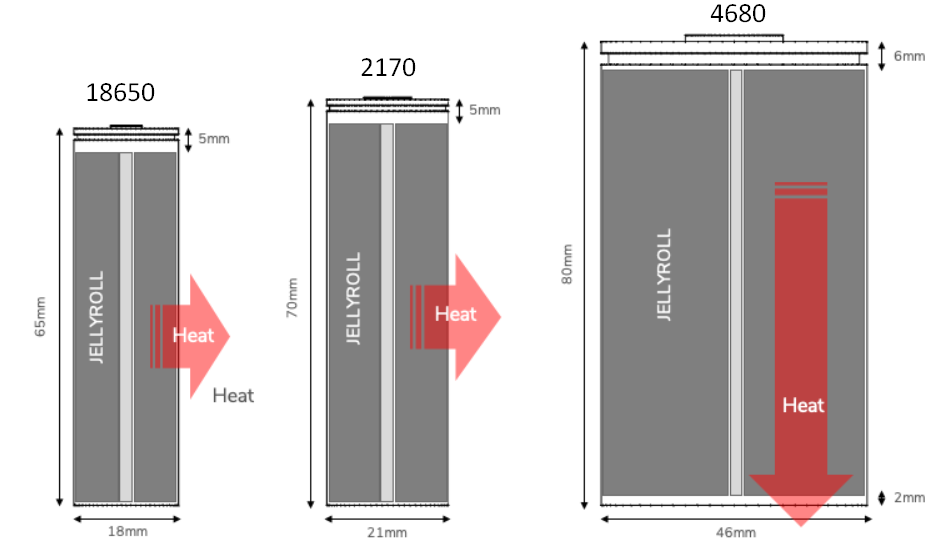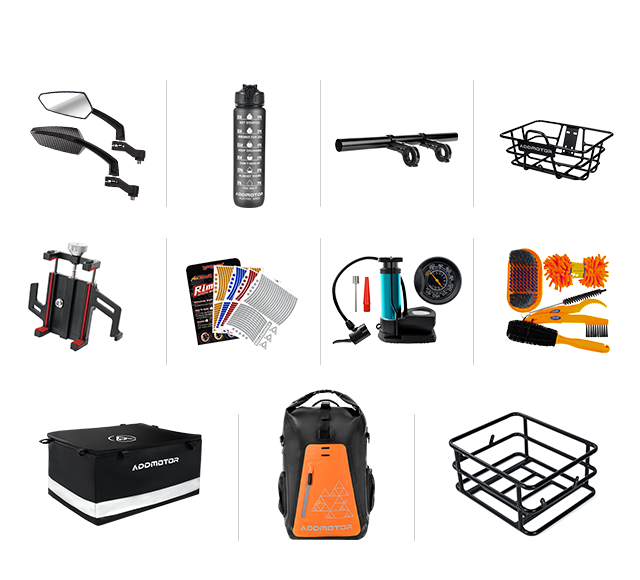ADDTECH | The Future of 18650 Lithium-ion Batteries
By Addmotor | 28 February 2024 | 1 Comments
Lithium-ion batteries are the most widely used power sources for electric bikes and devices. Among them, the 18650 battery is one of the most common and versatile types, with a cylindrical shape and a size of 18 mm in diameter and 65 mm in length.
But as technology advances and new battery formats emerge, will the 18650 battery be out? What are its pros and cons, and how does it compare to the latest 4680 battery, which promises to revolutionize the electric trike industry?
Explore all these and more, to have a comprehensive overview of the future of 18650 lithium-ion batteries.

The 18650 battery was first developed by Panasonic in 1994 in response to the increasing demand for smaller, lighter batteries with extended durability. Since then, it has become the standard battery format for many applications, such as laptops, power tools, flashlights, and electric bicycles.
The 18650 battery has a high energy density, meaning it can withstand a lot of energy in a small volume, and a long cycle life without losing much capacity. It is also relatively cheap, easy to manufacture, and widely available in the market.
However, the 18650 battery also has some limitations and drawbacks, which have prompted the development of new battery formats such as the 21700, that aim to overcome them.
As per Science Direct, “despite having higher gravimetric energy densities of up to ∼260 Wh kg−1, the energy density of current state-of-the-art Lithium-ion Batteries will soon reach its theoretical limit (∼300 Wh kg−1)”.
The current best-performing 18650 battery falls short of meeting these technical requirements, with maximum domestic batteries ranging between 100 and 150 Wh/kg. Here, the 21700 battery, which already boasts increased energy density, is likely to be a top consideration.
While this represents a future trend, it remains uncertain whether domestic companies will adopt 21700 batteries as extensively as they did with 18650 batteries. The main reason for this is that the 18650 battery, having a long history of development and accumulation, demonstrates strong adaptability and has carved out a large market space with diverse applications. Beyond electric vehicles, it is also used in notebook computers, 3C digital devices, drones, power tools, and other fields.
However, the 21700 battery faces challenges, as there is currently no effective industrial chain established, leading to potential cost escalation in its promotion. Moreover, the domestic power battery market has only gradually developed in recent years, with most production lines geared towards the production of 18650 batteries.
Some companies have committed to an 18650 production capacity for the coming years, indicating a promising future for the 18650 battery. With this, we can say that 18650 batteries will lead the market for many more years to come.
A typical 18650 battery has a capacity of 1200mah~3500mah and a voltage of 3.6V, 3.8V, and 4.2V, which IS far higher than 1.2 V of nickel-cadmium and nickel-metal hybrid batteries.
Disadvantages
These batteries deliver a smooth ride, even on challenging terrains, as they can meet the high power demands of ebike motors in such conditions. Additionally, 18650 batteries don't suffer from memory retention issues, ensuring long-term usage with proper management.
18650 Lithium-ion batteries designed for ebikes are typically lightweight and compact, reducing the overall weight of the bike. This weight reduction enhances maneuverability and speed. The compact size of Lithium batteries also allows flexible placement on the bike without protruding or causing interference.
According to Tesla, the 4680 battery offers several advantages over the 18650 battery and other battery formats, such as:
However, the 4680 battery also has some challenges and drawbacks, which must be addressed. Some of these are
Image Source: https://www.enpowerinc.com/tesla-battery-day-enpowers-take/
The 18650 batteries have been a staple in various applications, known for their resilience, safety, and efficiency. However, as technology evolves, the rise of the 4680 battery brings promising advancements.
Ultimately, both the 4680 and 18650 lithium batteries are excellent choices for different applications.
But as technology advances and new battery formats emerge, will the 18650 battery be out? What are its pros and cons, and how does it compare to the latest 4680 battery, which promises to revolutionize the electric trike industry?
Explore all these and more, to have a comprehensive overview of the future of 18650 lithium-ion batteries.

The Future Of 18650 Lithium-Ion Batteries: Will It Be Out?
The 18650 battery was first developed by Panasonic in 1994 in response to the increasing demand for smaller, lighter batteries with extended durability. Since then, it has become the standard battery format for many applications, such as laptops, power tools, flashlights, and electric bicycles. The 18650 battery has a high energy density, meaning it can withstand a lot of energy in a small volume, and a long cycle life without losing much capacity. It is also relatively cheap, easy to manufacture, and widely available in the market.
However, the 18650 battery also has some limitations and drawbacks, which have prompted the development of new battery formats such as the 21700, that aim to overcome them.
As per Science Direct, “despite having higher gravimetric energy densities of up to ∼260 Wh kg−1, the energy density of current state-of-the-art Lithium-ion Batteries will soon reach its theoretical limit (∼300 Wh kg−1)”.
The current best-performing 18650 battery falls short of meeting these technical requirements, with maximum domestic batteries ranging between 100 and 150 Wh/kg. Here, the 21700 battery, which already boasts increased energy density, is likely to be a top consideration.
While this represents a future trend, it remains uncertain whether domestic companies will adopt 21700 batteries as extensively as they did with 18650 batteries. The main reason for this is that the 18650 battery, having a long history of development and accumulation, demonstrates strong adaptability and has carved out a large market space with diverse applications. Beyond electric vehicles, it is also used in notebook computers, 3C digital devices, drones, power tools, and other fields.
However, the 21700 battery faces challenges, as there is currently no effective industrial chain established, leading to potential cost escalation in its promotion. Moreover, the domestic power battery market has only gradually developed in recent years, with most production lines geared towards the production of 18650 batteries.
Some companies have committed to an 18650 production capacity for the coming years, indicating a promising future for the 18650 battery. With this, we can say that 18650 batteries will lead the market for many more years to come.
Advantages and Disadvantages of Using 18650 Lithium-ion Batteries
Advantages♦ High Energy Density
The 18650 battery can store a lot of energy in a small volume, which makes it ideal for applications where weight and size are important, such as laptops, smartphones, and electric bicycles.A typical 18650 battery has a capacity of 1200mah~3500mah and a voltage of 3.6V, 3.8V, and 4.2V, which IS far higher than 1.2 V of nickel-cadmium and nickel-metal hybrid batteries.
♦ Low Self-Discharge Rate
This type of battery has a low self-discharge rate, contributing to its extended lifespan compared to other rechargeable batteries. With this advantage, these batteries can retain their charge for an extended period, which makes them well-suited for emergency backup power supplies.♦ Large Number of Charging Cycles
Unlike other rechargeable batteries, the 18650 battery can be recharged hundreds of times without losing much capacity, which makes it durable and reliable. A typical 18650 battery can last for 500 to 1000 cycles, depending on the quality and the conditions. This means that an 18650 battery can last for several years, or even decades if it is properly maintained and used.♦ High Safety Performance
The positive and negative electrodes of the 18650 lithium battery are intentionally separated to mitigate the risk of short-circuiting. This design minimizes the occurrence of short-circuit incidents. Additionally, it is non-toxic and pollution-free, having received RoHS trademark certification for adherence to environmental standards.♦ Temperature Characteristics
These batteries demonstrate high-temperature resistance, maintaining 100% efficiency even at temperatures as high as 65 degrees Celsius. This resilience makes it suitable for applications in environments with elevated temperatures.Disadvantages
♦ Temperature Sensitivity:
Though 18650 lithium batteries have good stability within a specific temperature range, it's important to note that extreme low or high-temperature environments can affect the overall performance of the batteries.♦ Size and Shape
The 18650 battery has a fixed cylindrical shape, which limits its flexibility and adaptability to different designs and spaces. Moreover, the cylindrical shape of the 18650 battery creates gaps and spaces between the cells, which reduces the packing density and the overall energy capacity of the battery pack.♦ High Cost
The production cost of 18650 lithium batteries is relatively higher when compared to alternative battery technologies like lead-acid batteries.♦ Fixed Volume
The fixed size of 18650 lithium batteries can pose challenges when fitting them into certain devices, such as notebook computers or other products. However, this limitation can also be viewed as an advantage, particularly for products that explicitly specify a certain battery size, in contrast to the variable size disadvantage of other lithium-polymer and lithium-ion batteries.♦ Risk of Short Circuits or Explosions
There is a potential risk of short circuits or explosions associated with 18650 lithium-ion batteries, a concern shared with lithium polymer batteries. However, for standard or ordinary batteries, this defect may not be as obvious.♦ Processing Requirements
The processing of 18650 lithium-ion batteries necessitates a defensive line to address the risk of overcharging and subsequent discharge. This precaution is crucial for lithium-ion batteries in general due to the use of lithium cobalt oxide materials, which have limitations in terms of large current discharge, posing safety challenges.The Effects When 18650 Lithium-Ion Batteries Are Applied On An Ebike
1. Longer Rides and Reliable Performance
18650 Lithium batteries, the powerhouse behind many ebikes, boast an impressive lifespan, allowing you to recharge them up to 500 times. Their extended range, combined with excellent battery density, ensures that your ebike stays charged for a considerable duration. These batteries deliver a smooth ride, even on challenging terrains, as they can meet the high power demands of ebike motors in such conditions. Additionally, 18650 batteries don't suffer from memory retention issues, ensuring long-term usage with proper management.
2. Portable and Convenient
When it comes to ebikes, speed matters, and weight plays a crucial role in achieving it. The weight of an ebike, influenced by components like the electric motor, bike frame, and battery, impacts its speed. 18650 Lithium-ion batteries designed for ebikes are typically lightweight and compact, reducing the overall weight of the bike. This weight reduction enhances maneuverability and speed. The compact size of Lithium batteries also allows flexible placement on the bike without protruding or causing interference.
3. Eco-Friendly and Sustainable
Opting for a 18650 Lithium-ion battery for your ebike contributes significantly to reducing your carbon footprint and benefiting the environment. These batteries do not contain harmful chemicals like Lead and Cadmium. This eco-friendly aspect ensures that when it's time to dispose of them, they pose no threat to the environment.
The Rise Of The 4680 Battery, Will It Change The Power Era?
The 4680 battery is a new type of lithium-ion battery that was unveiled by Tesla in 2020, and that claims to be a game-changer for the electric vehicle industry. The 4680 battery has a cylindrical shape and a size of 46 mm in diameter and 80 mm in length, which is much larger than the 18650 battery.According to Tesla, the 4680 battery offers several advantages over the 18650 battery and other battery formats, such as:
♦ Enhanced Energy Density: With an energy density up to 5 times higher than the previous 2170 cells, which translates to a 16% increase in range, the 4680 battery can store more energy in a smaller volume. This advancement can lead to enhancing the range, lower battery weight, and electric vehicle performance.
♦ Higher Power Output: The 4680 battery can deliver more power per unit volume at once, with its 6 times higher power output capacity. This enhances the acceleration and the speed of the electric vehicle.
♦ Improved Heat Dissipation: Tesla's "tabless" electrode design aims to address the common issue of poor heat dissipation in larger cylindrical cells. This innovation allows for more uniform temperature distribution within the cell, enhancing overall efficiency.
♦ Enhanced Thermal Performance: The same "tabless" design facilitates efficient heat sinking through copper and aluminum current collectors, minimizing thermal challenges. This ensures better temperature control within the cell and effective bottom-side cooling in a battery pack.
♦ Affordability: The use of NCA in the 4680 cells makes them cheaper to produce, enabling Tesla to decrease the overall cost of production and make electric cars more accessible to a broader consumer base.
♦ Versatility: The 4680 cells will be used in various Tesla models, including the Cybertruck, Semi, Roadster, and upcoming Model S and Model X refresh, showcasing their versatility across different vehicle types.
However, the 4680 battery also has some challenges and drawbacks, which must be addressed. Some of these are
♦ Limited Fast-Charging Capabilities: Despite addressing heat-sinking challenges, the "tabless" design doesn't necessarily improve fast-charging capabilities. The 4680 form factor may not charge as rapidly as smaller cylindrical or pouch cell formats due to efficiency variations in heat dissipation.
♦ Challenges in Extreme Fast Charging (XFC): The energy-to-power tradeoff and limitations in extreme fast charging (XFC) primarily result from ions' slower movement through unit-cell structures. While the "tabless" design tackles electronic resistance, it may not fully address the impediments to extreme fast charging.
♦ Production Challenges: Difficulties in lug welding technology and the dry electrode process have been identified, which may impact production yields.
♦ Internal Heat Dissipation Challenges: The positive and negative electrodes inside the 4680 cylindrical lithium battery pose challenges for internal heat dissipation. This could potentially affect the overall lifespan of the battery.
Comparison Between 4680, 18650, and 21700 Batteries

Image Source: https://www.enpowerinc.com/tesla-battery-day-enpowers-take/
| Specification | 18650 | 21700 | 4680 |
| Size | 18 x 65 | 21 x 70 | 46 x 80 |
| Capacity | 3,500 | 5,00 | 9,000 |
| Protection Elements | PTC, CID, Fusible link, PCB | PTC, CID, PCB | Innovative "tabless" design, thermal management |
| Design & Structure | Rolled sheets, cylindrical | Slightly larger cylindrical | Shingle-spiral, "tabless" design |
| Number of Cells per Pack | More needed | Fewer needed, about one-third | Significantly fewer needed |
| Power per Pack | Less power | More power | Even more power |
| Net weight (Max) grams | 50 | 70 | 355 |
| Cell Energy Density max (Wh/Kg) | 250 | 276 to 300 | 276 to 333 |
| Cycle Life | 300–500 | 1500-4000 | 1000-2000 |
In Conclusion,
The future of lithium-ion batteries, particularly the widely-used 18650 format, is undergoing a significant transformation with the emergence of the 4680 battery.The 18650 batteries have been a staple in various applications, known for their resilience, safety, and efficiency. However, as technology evolves, the rise of the 4680 battery brings promising advancements.
Ultimately, both the 4680 and 18650 lithium batteries are excellent choices for different applications.
Recently Reviews
Read MoreLeave a Reply
Your email address will not be published.Required fields are marked. *
Latest Stories




